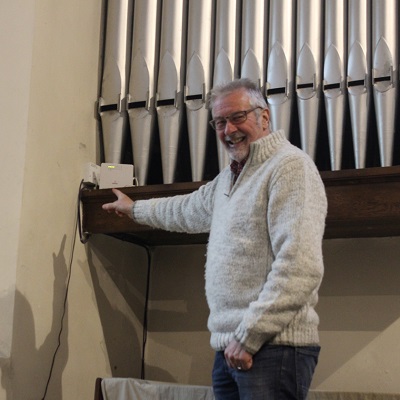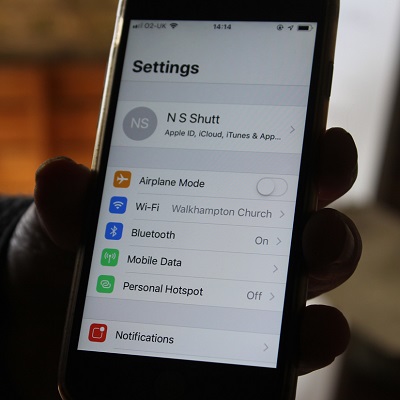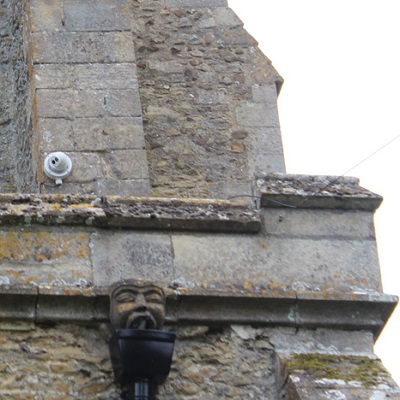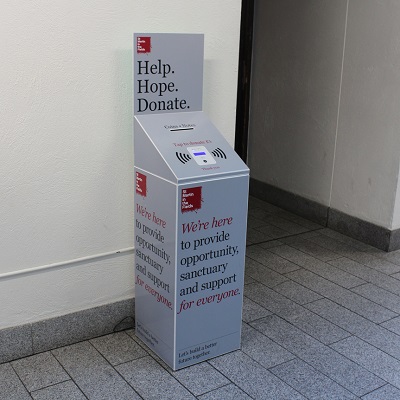What can connectivity do for your church building? Have a browse through the case-studies and videos on this page. And if you'd like to find out what technical solutions are available in your location, click here.
Mission and engagement
Connectivity offers many practical benefits for churches. But there are benefits in terms of mission too.
Interactive electronic displays and app-based guided tours can bring cathedrals and larger churches to life for visitors. And while these won’t be appropriate for every church building, engagement can be increased in other ways:
- providing interactive audio-visual accompaniments for services
- collecting contact details in a digital guestbook
- offering visitors the opportunity to log in to guest WiFi
- live-streaming services, concerts, or other community events – even weddings.
The only limit is your imagination. (And, perhaps, your broadband speed.)
Where the church building also serves as a regular workplace for clergy and church personnel, connectivity is needed to conduct daily business: maintaining church websites, updating social media accounts and other communication channels. Not to mention record-keeping and bank-accounts transactions. All of these activities contribute in their own small way to our mission.
Community uses
Churches serve their communities in many ways. First and foremost, they are places of worship; but there are plenty of other opportunities for a church building to provide for local needs.
Connectivity will play an increasingly important role if our churches are to retain their place in people's lives. As communal spaces, church buildings provide a unique and often much-needed location for people to meet and interact. Introducing mobile or internet technologies can provide a real boost to the utility of the space.
Large and small, urban and rural, churches across England have served as post offices, community shops, art galleries, after-school clubs, youth-work outreach centres, night-shelters, and food-banks. And as venues hosting adult-learning classes, film screenings, counselling services, and citizens’ advice.
So many vital functions which contribute to community cohesion can be offered by our buildings; and many are no longer offered anywhere else in the community. Access to internet services, social media, and telephone and text-messaging capability are increasingly thought just as important to many visitors as warmth, shelter, and furniture.
In places where the wider community is struggling with slow internet speeds or a lack of mobile-phone reception (so-called ‘not-spots’) church towers and steeples can sometimes serve as hubs to redistribute signals, generating income for the church and providing an invaluable service to the surrounding parish – thus benefiting the church, both practically and missionally.
Welcome and hospitality
People visit churches for all sorts of reasons – whether social, spiritual, religious, historical, or just plain curiosity. Irregular visitors can, and should, be made to feel just as welcome as regular ones.
Being open as often as possible will help your church building to provide your community and its visitors with a space for reflection, contemplation and prayer; to link them to others, past and present. And it might also provide opportunities for mission.
How much of a part technology plays in your welcome will depend on the connectivity available, and what you feel is appropriate. Some larger churches and cathedrals are introducing "virtual tours" using building-interpretation mobile apps, QR codes, Bluetooth beacons, augmented reality, and all the latest technical wizardry to enrich visitors' experiences.
For smaller parish churches, a visitors' book and a biro – perhaps alongside a leaflet explaining the history of the building – may have sufficed for many years. But where connectivity is available, it can be harnessed to replicate these functions at very little cost. It can also help to make your church a welcoming and hospitable destination for visitors to enjoy, and to allow them to share their experiences of your church with others; potentially bringing more visitors to your door.
Security
Church security is hugely important – especially when balanced with the need to make our buildings open and welcoming places at the heart of the community.
Connectivity allows for a wide range of options in this department, which simply would not be available otherwise. Alarm systems can be connected via broadband or mobile networks to third-party services, so that they become much more than mere deterrents, and shift some of the burden for day-to-day church-care from churchwardens and neighbours.
For larger churches or church buildings which find themselves particularly at risk from crime, preventative measures such as CCTV facilities can be hugely improved by connectivity services. Better church security will help PCCs and potentially have positive implications on long-term running-costs in terms of insurance policies, and the repair or replacement of stolen or damaged church property.
Funding
In times of great change, in technology and public spending habits, it’s important that our churches aren't left behind.
In other words: in a cashless society, our collection plates could soon become empty. Giving is an important part of our communal church life; and it’s also a common part of a visitor’s experience – either in the form of leaving a donation in an unattended box by the door, or donating a small amount for candles, cakes, postcards, etc.
As the rest of the world marches on toward a future in which metal and paper (or even modern "polymer" notes) have largely given way to chip-and-pin, contactless tapping, and phone payments, embracing these modern methods will become vital for the sustainability of our church buildings.
Card-readers help in the diversification of church use, allowing for on-the-door payment if concerts, community groups, or other events are held in a church, and helping on-site shops or cafes realise their potential. Allowing text-giving, online payments and unattended contactless devices (where connectivity of some kind is available) have been shown to increase donations in many churches and cathedrals where they’ve been deployed.
Where suppliers wish to use a church tower or spire to host wireless-broadband or mobile-network infrastructure, this can also provide a regular income to a church. And the installation can provide the church building with the connectivity it needs to take advantage of many of the benefits mentioned on this page.
Flexibility
Church buildings are some of the oldest and most treasured examples of our architectural heritage. Older buildings can require a lot of care and attention compared with the new ones; but modern technology can help ease the burden of care – logistically and financially – in both.
Provided there is an internet connection, 'smart technology' can allow for heating and lighting to be controlled remotely (and locally) so that churches can be prepared to provide a more inviting environment for worship, or other uses. This can help save time – reducing the necessity for volunteers to arrive hours before everyone else – but also money, and energy; making our churches more energy-efficient and sustainable.
The same technology can also provide opportunities for remotely controlling access to churches and cathedrals; as well as other aspects of church services or church-based events, such as audio-visual systems. Whatever technology you want to make use of in your church building, connectivity will allow for more flexible use. And while 'smart churches' might currently seem a rather futuristic concept, church buildings of all shapes and sizes across the country are now embracing connectivity, so it might only be a matter of time...
Case study: St Michael & All Angels, Martlesham Heath, St Edmundsbury & Ipswich
Useful links:
- Advice and guidance on 'Lighting' from ChurchCare
- Advice and guidance on 'Heating' from ChurchCare
- The 'Loxone Smart Church' case study, by a private company in Austria
NB – The above Loxone case study is provided purely for your information. The company is neither affiliated with the Church of England, nor do we recommend their services. Any suppliers of connectivity services who have entered into agreements with Church of England Central Services are featured in the relevant section on Parish Buying.





